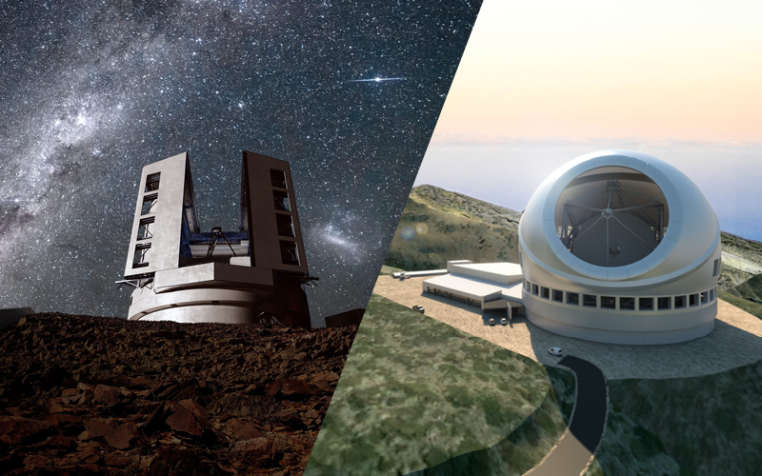NSF Likely to Drop One of Two Giant Telescopes From Consideration for Construction Funds

Renderings of the Giant Magellan Telescope, left, and the Thirty Meter Telescope.
Left: GMTO Corporation / Right: M3 Engineering
The National Science Foundation’s governing board has set a $1.6 billion ceiling on the agency’s potential contribution of construction funding for the Thirty Meter Telescope (TMT) and/or the Giant Magellan Telescope (GMT). The decision, announced
In particular, the board has asked NSF to report back by May on “its plan to select which of the two candidate telescopes the agency plans to continue to support.”
Asked for clarification on this statement, a board spokesperson replied, “Based on what the board knows now, it anticipates that a down-selection will be necessary.” The spokesperson also said the board looks forward to getting an update in May on the status of “partner contributions” to the projects.
NSF has funded
The GMT’s partner institutions have committed more than $850 million in cash and in-kind contributions to date toward a total project cost of $2.54 billion, according to a spokesperson for the project. The TMT’s partners have contributed cash and in-kind contributions totalling $2.0 billion, according to a spokesperson for the TMT. The spokesperson did not offer an estimate of the total cost of the TMT, stating the amount is “dependent upon a number of factors, in particular the schedule.”
Construction of the GMT has already begun in Chile, but TMT construction on Mauna Kea in Hawaii has been paused since 2019 due to reservations from local community members who view the mountain as sacred. The TMT has considered using a site in the Canary Islands as an alternative.
The NSF board’s action does not guarantee that the agency will seek construction funds for even one of the telescopes, and the ultimate contribution may be well less than $1.6 billion even if it proceeds. The agency is weighing proposals for other major scientific infrastructure projects both across other disciplines and within astronomy itself, which has struggled in recent years to cover the operations costs of new telescopes.
The ultimate arbiter of what will be funded is Congress, which controls NSF’s construction budget on a project-by-project basis.
NSF construction budget has fallen short of aspirations
The $1.6 billion cost cap set by the board is equal to the level of spending proposed
The survey’s top priority for new ground-based astronomy facilities is for NSF to fund the construction of at least one of the telescopes, preferably both. It suggested that NSF contribute $800 million to each telescope in exchange for a 25% share of observing time for each. Under a scenario where NSF only supports one of the telescopes, the survey recommended that the agency raise its funding contribution above $800 million to secure additional observing time, up to 50%.
“The success of at least one of these projects is absolutely essential if the United States is to maintain a position as a leader in ground-based astronomy,” the survey argued. It pointed in particular to competition posed by the European Southern Observatory, which is already more than halfway complete
The survey presented a notional annual construction funding profile for the telescopes that began in 2023 and peaked in 2025 at around $350 million. It assessed that such a profile would be manageable under the aspirational budget scenario that NSF provided to the survey.

Chart presenting a notional funding profile for the Extremely Large Telescope program, which manages NSF support for the TMT and GMT.
(National Academies)
So far, NSF’s construction budget has proven to be much more constrained than the aspirational scenario.
Congress allocated $187 million for NSF construction projects in fiscal year 2023, split between Antarctic infrastructure modernization, mid-scale research infrastructure, the Vera C. Rubin Observatory, and detector upgrades at the Large Hadron Collider.
Although the Rubin and LHC projects are near the end of their construction profiles, a huge backlog of infrastructure work remains in Antarctica, and the mid-scale infrastructure program has proven very popular across scientific disciplines. Both could retain large shares of the construction budget for years to come.
In addition, NSF recently proposed to launch a new supercomputer acquisition project that is expected to cost at least $520 million. In its fiscal year 2024 budget request, NSF asked Congress to increase the construction account to $305 million, with nearly $100 million of the increase going to start the supercomputer project.
Congress has yet to finalize NSF’s appropriation for the fiscal year, but both the House and Senate figures for the construction account are well below the request. The Senate proposed flat funding and the House proposed $254 million.
The NSF board cautioned in its announcement this week that even if the agency’s contribution to the telescopes is capped at $1.6 billion, that amount would likely consume most of the agency’s annual budget for construction projects at a time of high demand for new research infrastructure.
“The board recognizes there are compelling [construction] needs across a wide range of science and engineering fields, as well as other astronomy needs expressed in the Astro2020 decadal survey,” it explained.
Construction queue increasingly crowded
NSF officials have sought to manage scientists’ expectations over how much construction money will be available.
“I think the community labors under the misapprehension that putting a facility into the very beginning of the design stage implies that NSF is committed to building that facility; that is not the case,” said Denise Caldwell, acting head of NSF’s Mathematical and Physical Sciences (MPS) Directorate, at an advisory committee meeting last year. “Anywhere in the design process, the design can be stopped and an off-ramp developed, and the project will never come to construction,” she added.
Caldwell explained that NSF’s process contrasts with that of the Department of Energy, which generally makes a firmer commitment to projects that reach the design stage. She also emphasized that other major projects within the MPS Directorate are vying for funds, as are projects from other directorates across NSF.
Ranked just below the TMT and GMT in priority by the Astro2020 decadal survey are the Cosmic Microwave Background Stage 4 (CMB-S4) project and the Next Generation Very Large Array (ngVLA). CMB-S4 is estimated to cost around $800 million,
Notably, particle physicists ranked CMB-S4 as their highest priority for new major projects
To give an example from outside the MPS Directorate, considerable work has already been done to design a new Antarctic Research Vessel.
In light of this high demand for infrastructure, the MPS Directorate recently formed a task force
“NSF currently faces an unprecedented challenge in setting priorities and managing design, construction, and operations costs, given the magnitude and number of requests from the scientific community,” the task force observed in its final report,
The task force recommended NSF maintain a portfolio of potential projects and review them together as a group. “Adopting this suggestion requires a significant modification of the existing process at NSF and a new vision for infrastructure,” it stated.
Note: This article has been updated to clarify that construction of the TMT began in 2019 but has been paused since then as the project works to gain support from the local community.


